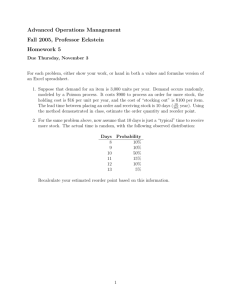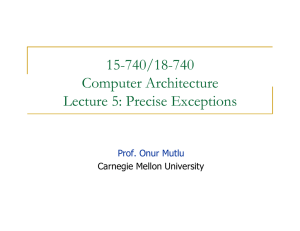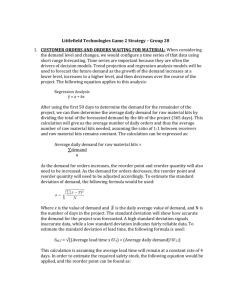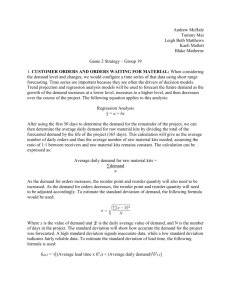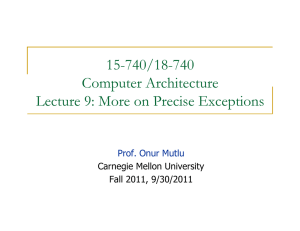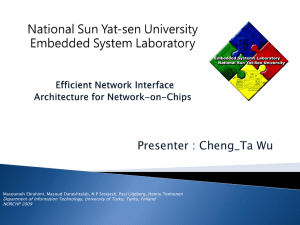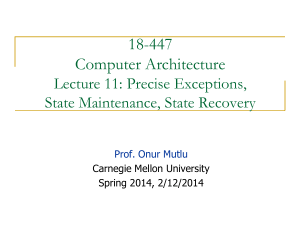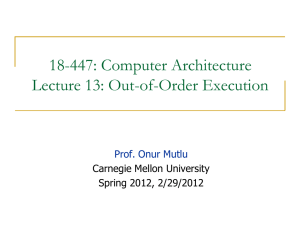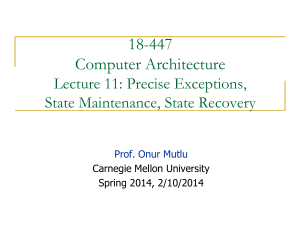15-740/18-740 Computer Architecture Lecture 8: Precise Exceptions Prof. Onur Mutlu
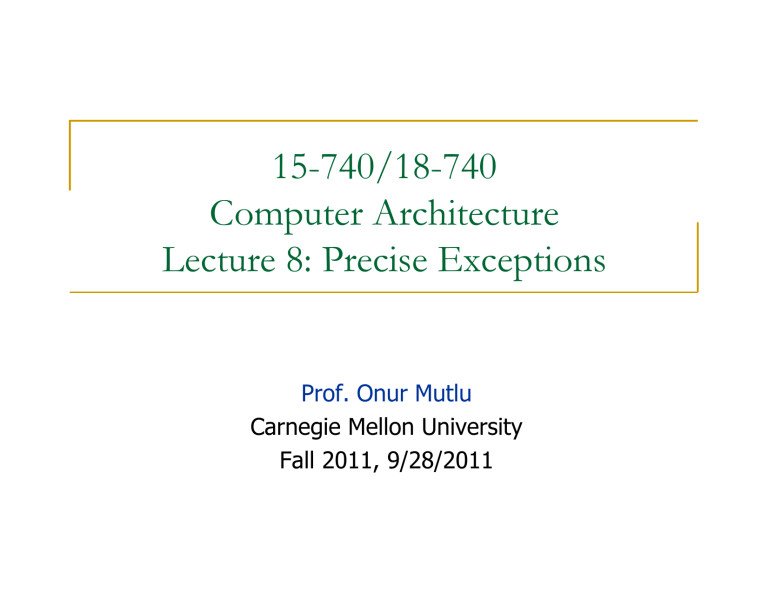
15-740/18-740
Computer Architecture
Lecture 8: Precise Exceptions
Prof. Onur Mutlu
Carnegie Mellon University
Fall 2011, 9/28/2011
Reminder: Papers to Read and Review
Review Set 5 – due October 3 Monday
Smith and Plezskun, “ Implementing Precise Interrupts in Pipelined
Processors ,” IEEE Transactions on Computers 1988 (earlier version:
ISCA 1985).
Sprangle and Carmean, “ Increasing Processor Performance by
Implementing Deeper Pipelines ,” ISCA 2002.
Review Set 6 – due October 7 Friday
Tomasulo, “ An Efficient Algorithm for Exploiting Multiple Arithmetic
Units, ” IBM Journal of R&D, Jan. 1967.
Smith and Sohi, “ The Microarchitecture of Superscalar Processors ,”
Proc. IEEE, Dec. 1995.
2
Review of Last Lecture
More performance metrics
Microcoded machines
Pipelining
Issues in pipelining
3
Today
More issues in pipelining
Precise exceptions
4
Causes of Pipeline Stalls
Data dependencies
Control dependencies
Resource contention
5
Review: Issues in Pipelining: Increased CPI
Data dependency stall: what if the next ADD is dependent
ADD R3 R1, R2
ADD R4 R3, R7
F D E W
F D D D E W
Solution: data forwarding. Can this always work?
How about memory operations? Cache misses?
If data is not available by the time it is needed: STALL
What if the pipeline was like this?
LD R3 R2(0)
ADD R4 R3, R7
F D E M W
F D E E M W
R3 cannot be forwarded until read from memory
Is there a way to make ADD not stall?
6
Review: Implementing Stalling
Hardware based interlocking
Common way: scoreboard i.e. valid bit associated with each register in the register file
Valid bits also associated with each forwarding/bypass path
Instruction
Cache
Register
File
Func Unit
Func Unit
Func Unit
7
Issues in Pipelining: Increased CPI
Control dependency stall : what to fetch next
BEQ R1, R2, TARGET F D E W
F F F D E W
Solution: predict which instruction comes next
What if prediction is wrong?
Another solution: hardware-based fine-grained multithreading
Can tolerate both data and control dependencies
Read: James Thornton, “ Parallel operation in the Control Data
6600, ” AFIPS 1964.
Read: Burton Smith, “ A pipelined, shared resource MIMD computer, ” ICPP 1978.
8
Issues in Pipelining: Increased CPI
Resource Contention Stall
What if two concurrent operations need the same resource?
LD R1 R2(4)
ADD R2 R1, R5
ADD R6 R3, R4
F D E W
F D E W
F F D E W
Examples:
Instruction fetch and data fetch both need memory. Solution?
Register read and register write both need the register file
A store instruction and a load instruction both need to access memory. Solution?
9
Issues in Pipelining: Multi-Cycle Execute
Instructions can take different number of cycles in
EXECUTE stage
Integer ADD versus FP MULtiply
FMUL R4 R1, R2
ADD R3 R1, R2
FMUL R2 R5, R6
ADD R4 R5, R6
F D E E E E E E E E
F D E W
F D E W
W
F D E W
F D E E E E E E E E
F D E W
F D E W
What is wrong with this picture?
What if FMUL incurs an exception?
Sequential semantics of the ISA NOT preserved!
W
10
Handling Exceptions in Pipelining
Exceptions versus interrupts
Cause
Exceptions: internal to the running thread
Interrupts: external to the running thread
When to Handle
Exceptions: when detected (and known to be non-speculative)
Interrupts: when convenient
Except for very high priority ones
Power failure
Machine check
Priority: process (exception), depends (interrupt)
Handling Context: process (exception), system (interrupt)
11
Precise Exceptions/Interrupts
The architectural state should be consistent when the exception/interrupt is ready to be handled
1. All previous instructions should be completely retired.
2. No later instruction should be retired.
Retire = commit = finish execution and update arch. state
12
Why Do We Want Precise Exceptions?
Aid software debugging
Enable (easy) recovery from exceptions, e.g. page faults
Enable (easily) restartable processes
Enable traps into software (e.g., software implemented opcodes)
13
Ensuring Precise Exceptions in Pipelining
Idea: Make each operation take the same amount of time
FMUL R3 R1, R2
ADD R4 R1, R2
F D E
F D
E E E E E E E
E E E E E E E
W
E W
F D E E E E E E E
F D
E W
E E E E E E E E W
F D E E E E E E E
F D
E W
E E E E E E E E W
F D E E E E E E E E W
Downside
What about memory operations?
Each functional unit takes 500 cycles?
14
Solutions
Reorder buffer
History buffer
Future register file
Checkpointing
Reading
Smith and Plezskun, “ Implementing Precise Interrupts in Pipelined
Processors ” IEEE Trans on Computers 1988 and ISCA 1985.
Hwu and Patt, “ Checkpoint Repair for Out-of-order Execution
Machines , ” ISCA 1987.
15
Solution I: Reorder Buffer (ROB)
Idea: Complete instructions out-of-order, but reorder them before making results visible to architectural state
When instruction is decoded it reserves an entry in the ROB
When instruction completes, it writes result into ROB entry
When instruction oldest in ROB and it has completed, its result moved to reg. file or memory
Instruction
Cache
Register
File
Func Unit
Func Unit
Func Unit
Reorder
Buffer
16
Reorder Buffer: Independent Operations
Results first written to ROB, then to register file at commit time
F D E E E E E E E E
F D E
F D
R
E R
F D E R
R W
W
W
F D E E E
F D E R
E E E E E
F D E R
W
R W
W
W
What if a later operation needs a value in the reorder buffer?
Read reorder buffer in parallel with the register file. How?
17
Reorder Buffer: How to Access?
A register value can be in the register file, reorder buffer,
(or bypass paths)
Instruction
Cache
Register
File
Content
Addressable
Memory
(searched with register ID)
Reorder
Buffer
Func Unit
Func Unit
Func Unit bypass path
18
Simplifying Reorder Buffer Access
Idea: Use indirection
Access register file first
If register not valid, register file stores the ID of the reorder buffer entry that contains (or will contain) the value of the register
Mapping of the register to a ROB entry
Access reorder buffer next
What is in a reorder buffer entry?
V DestRegID DestRegVal StoreAddr StoreData BranchTarget PC/IP Control/valid bits
Can it be simplified further?
19
What is Wrong with This Picture?
FMUL R4
ADD R3
R1, R2
R1, R2
FMUL R2 R5, R6
ADD R4 R5, R6
F D E E E
F D E W
E E E E E W
F D E W
F D E W
F D E E E
F D E W
E E E E E
F D E W
W
What is R4 ’ s value at the end?
The first FMUL ’ s result
Output dependency not respected
20
Register Renaming with a Reorder Buffer
Output and anti dependencies are not true dependencies
WHY? The same register refers to values that have nothing to do with each other
They exist due to lack of register ID ’’’’ s (i.e. names) in the ISA
The register ID is renamed to the reorder buffer entry that will hold the register ’ s value
Register ID ROB entry ID
Architectural register ID Physical register ID
After renaming, ROB entry ID used to refer to the register
This eliminates anti- and output- dependencies
Gives the illusion that there are a large number of registers
21
